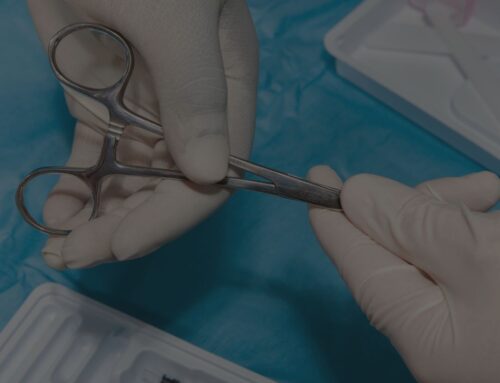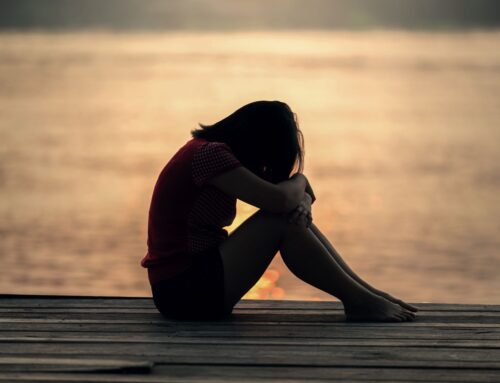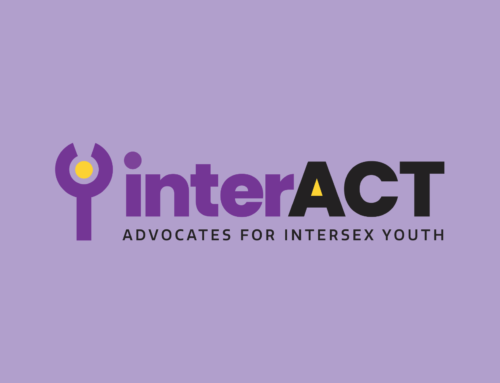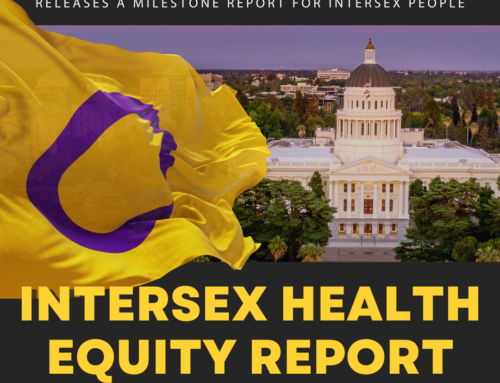AIC is proud to share the first in a series of interviews with key leaders and supporters who have helped make AIC the strong organization we are today! To kick off the series and in celebration of her upcoming 45th Birthday, our first interview is with AIC Executive Director Anne Tamar-Mattis:
1. How did you become involved with or what’s your first memory of hearing about AIC?
I founded AIC! The idea for a legal project grew out of a paper I wrote in law school, but I had been an ally of the intersex community ever since I met my spouse, Suegee, in the early 90’s. It was the beginning of the intersex movement, and through Suegee I met many other intersex activists and leaders. When I went to law school, many of my intersex friends asked me why it was that the law had done so little to protect them as children. I began to investigate, and learned that there was a lot we could do through legal advocacy to protect the rights of children with intersex traits. But there was no organization with specialized knowledge of intersex issues that had ever tried to take on this issue. Once I realized that, I knew we had to start something new, and AIC was born.
2. How has connection with AIC impacted your life?
AIC has had an enormous impact on my life. I’ve been doing this for over seven years now, and I’ve gotten to meet so many amazing and powerful people from around the country and around the world — intersex youth and adults, children, parents, allies. I’ve been invited to address universities, law schools, medical societies, and even the United Nations Special Rapporteur on Torture and a committee of the World Health Organization. The biggest honor, though, is to be able to see this movement blossom into an international community that is finding its voice and its power through the actions of brave intersex people and allies. It is truly a privilege to work with this community.
3. What do you find most challenging in building support for intersex children and families?
The most challenging aspect of this work is the fact that the community is so heavily impacted by secrecy, shame, and trauma. It makes it hard for parents to connect with each other for support and information. It makes it hard for children and youth to find peers and role models they need desperately. It makes it hard for adults to find each other, and to tell their stories. There are many brave, resourceful, and strong intersex adults, youth, and families who have broken through these barriers to build community, but it is still very difficult. Those of us who care about intersex children will only be able to help them with the knowledge held by those who have lived in intersex bodies. The only way we will ever be able to make a world that is truly safe for intersex children is to support intersex people and their families in connecting with each other and speaking out, so that we can erase stigma and shame.
4. What do you find most rewarding in building support for intersex children and families?
The most rewarding thing for me is being a witness to the strength and grace possessed by so many of my intersex friends and colleagues. Many of them have had incredibly painful experiences, but they have chosen to live lives rich with love, and to use their experiences to help make the world a better place for each other and for the children who come after them. It is also deeply rewarding to see children with intersex traits who are growing up connected to a community, with parents who are not afraid to tell them the truth and allow them to make their own decisions about their bodies. These children will be the leaders of tomorrow.
5. What do you wish other people knew about the intersex movement and the intersections with other social justice movements and identities?
I wish there was more knowledge about intersex issues in other social justice movements generally. More and more, we see knowledge growing. But there is still a lot of misinformation and myth out there about intersex people. Because I came to this work through the LGBT movement, I am especially interested in the relationships between that community and the intersex community. The LGB and transgender communities have always been supportive of intersex rights, and have done a lot to open doors for intersex advocates and offer platforms for intersex voices. However, there are important difference between LGBT and intersex issues, and many in the intersex community don’t identify as LGBT. We need allies in the LGBT community to understand those differences, to educate each other, and to continue to make space for intersex organizations and intersex leaders to speak for themselves.
6. What change would you like to see over the next five years?
I would like to see a world in which we recognize that children with intersex traits, like all children, own their own bodies. This means an end to unnecessary and unwanted genital surgery, and an end to unnecessary medical display and harmful experimentation.
7. Who are important collaborators or partners to connect with AIC’s work.
We are building strong connections in the national and international human rights community. I would also like to see stronger collaboration with the disability rights movement, the reproductive justice movement, communities of color, and children’s rights organizations. We are also continuing our work with partners in the medical world, including with hospitals and teams of medical researchers. I would like to see more of these connections, so we can help design ethical research about issues that matter to our community.
In honor of Anne’s 45th Birthday and in recognition of her hard work and dedication to protecting the rights of children born with intersex traits, please make a gift to AIC dedicated to Anne by clicking here. Thank you.






